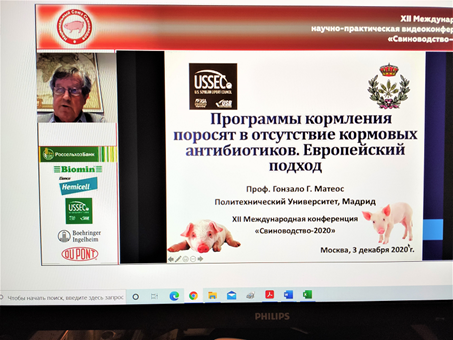
Russia Now Self-Sufficient in Satisfying Local Pork Demand, Aims to Export
USSEC recently attended the XXII International Pig Conference organized by the National Union of Swine Breeders of Russia and the International Industrial Academy in Moscow.
Today, Russia is the fifth-largest pork producer in the world. According to the National Union of Swine Breeders, pig farming is one of the most technologically advanced branches of agriculture in Russia.
To further strengthen ties with the Russian swine industry, the U.S. Soybean Export Council attended one of the country’s key annual events, the XXII International Pig Conference, hosted by the National Union of Swine Breeders of Russia and the International Industrial Academy in Moscow in December 2020.
In the keynote speech, Dr. Yuri Kovalev, who serves as the General Director of the National Union of Swine Breeders of Russia, said the country has reached self-sufficiency in the production of pork. Russia’s goal is to not only satisfy local demand but also increase production enough to be able to export surplus pork.
In Russia, the average annual growth rate for all animal protein production is 4.2%, compared to pork which has witnessed an annual growth rate of 9.7%. Pork leads growth of all animal protein sectors. In 2020, slaughter weight was estimated to be more than 4.3 MMT of pork.
Kovalev said the number of pigs at the end of June 2020 amounted to 218.15 million head, an increase of 6.56% compared to end of year 2019. By 2025, according to the forecast of the National Union of Swine Breeders, the total pig production for slaughter is estimated to be 6 million tons in live weight, almost 2 million tons more than in 2019.
When it comes to pork production, soy plays a key role. To discuss the benefits of using U.S. Soy, Gonzalo Mateos, a professor at the Polytechnic University of Madrid and a USSEC consultant, shared “Feeding programs for piglets in the absence of in-feed antibiotics: An European approach.”
In this study, he evaluated piglets in Spain after the ban of feed antibiotics for “no antibiotics ever” (NAE) piglets. Using science and practice-based data, Mateos shared the importance of optimizing piglet digestive health. Such diets are formulated with a low crude protein and calcium content but with a high-level of inert fiber.
He emphasized the importance of using high-quality soybean meal in these pre-starter piglet diets and shared the main characteristics of a good quality soy product, such as full-fat soybeans, high protein soybean meal, and soy oil. Mateos also discussed the importance of quality, energy content, and how these can be impacted by bean origin.
More than 850 people from 60 regions of Russia and 15 foreign countries attended the conference, including representatives of regional departments of the agribusiness, swine-breeding companies, research and educational institutions, media, and more. There were seven sessions, with 46 speakers detailing a wide range of issues, with speaker presentations translated into Russian.
USSEC will continue to promote the advantages of using U.S. Soy in animal feed and supplying end users with a trusted, consistent high-quality source of nutrients. Dare to Compare soy nutrients here.


